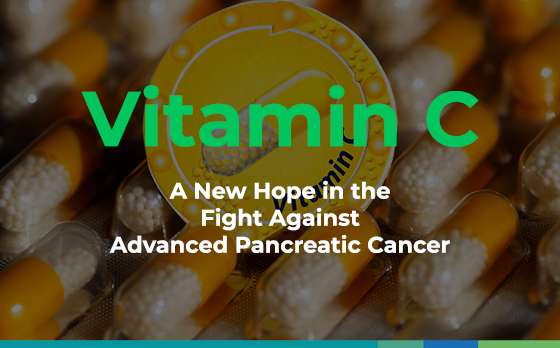Metastatic pancreatic cancer is one of the most aggressive and difficult-to-treat forms of cancer, with an average survival of less than a year. However, recent studies have explored new strategies to improve outcomes, including the use of high-dose vitamin C (administered intravenously at very high concentrations) as part of the treatment.
What Was Investigated in This Study?
A group of researchers from the University of Iowa conducted a clinical trial to evaluate whether intravenously administered vitamin C, combined with the standard drugs Gemcitabine and Nab-paclitaxel, could improve survival in patients with advanced pancreatic cancer. This additional treatment is based on the principles of redox biology, a field that studies the chemical processes cells use to manage oxidative stress.
When vitamin C is administered intravenously in very high doses, plasma concentrations dramatically increase to levels unattainable through oral supplementation. These high concentrations generate hydrogen peroxide (H₂O₂) in the extracellular environment. Tumor cells, due to their altered metabolism and reduced capacity to eliminate H₂O₂, are particularly sensitive to this compound, making them more vulnerable to damage and ultimately leading to cell death. In contrast, normal cells have more efficient antioxidant systems, providing them with protection.
Study Methodology
The trial included 36 patients diagnosed with stage IV pancreatic cancer, who were randomly divided into two groups:
– Control Group (SOC): Received standard treatment with Gemcitabine and Nab-paclitaxel.
– Experimental Group (ASC): Received the same standard treatment along with vitamin C infusions at a dose of 75 grams three times per week.
The study measured several aspects, including:
– Overall Survival: Time from the start of treatment to death from any cause.
– Progression-Free Survival: Time until the disease worsened.
– Quality of Life: Assessed through questionnaires designed to measure common symptoms in cancer patients.
Additionally, side effects and complications related to the treatment were carefully monitored.
Promising Results
The study found that patients who received vitamin C along with standard chemotherapy lived an average of 16 months, compared to 8.3 months for those who only received chemotherapy. Additionally, the time before disease progression was also longer in the vitamin C group (6.2 months compared to 3.9 months).
In terms of treatment tolerance, patients in the experimental group experienced fewer severe side effects, such as anemia and fatigue. Analyses indicated that vitamin C not only enhanced the efficacy of the drugs but also helped mitigate some of their adverse effects, likely by reducing oxidative damage to normal tissues.

Figure 1. Results of the trial, showing how the group treated with vitamin C and conventional chemotherapy has better results than the group treated only with chemotherapy.
What Does This Mean for Patients?
This approach combines the best of traditional medicine with an innovative intervention that leverages the altered metabolism of cancer cells. Although the results are preliminary, this study offers hope for patients with advanced pancreatic cancer. Adding vitamin C to standard treatment could not only extend life but also improve its quality by reducing the side effects of chemotherapy.
It is important to note that this approach is not yet widely available, and its implementation depends on further studies to confirm these benefits in a larger population. Therefore, any changes in treatment should always be discussed with the treating oncologist.
This study highlights the importance of innovation in the fight against cancer. Vitamin C, a compound known for its safety and low cost, could become a powerful tool in treating this devastating disease.
While the results are promising, they do not replace standard treatments but rather complement them. It is always essential to rely on scientific evidence and maintain open communication with the medical team to explore the best options available.
Main Reference:
Bodeker, K. L., Smith, B. J., Berg, D. J., Chandrasekharan, C., Sharif, S., Fei, N., Vollstedt, S., Brown, H., Chandler, M., Lorack, A., McMichael, S., Wulfekuhle, J., Wagner, B. A., Buettner, G. R., Allen, B. G., Caster, J. M., Dion, B., Kamgar, M., Buatti, J. M., & Cullen, J. J. (2024). A randomized trial of pharmacological ascorbate, gemcitabine, and nab-paclitaxel for metastatic pancreatic cancer. Redox Biology, 77(103375), 103375. https://doi.org/10.1016/j.redox.2024.103375
Other References:
Bodeker, K. L., Smith, B. J., Berg, D. J., Chandrasekharan, C., Sharif, S., Fei, N., Vollstedt, S., Brown, H., Chandler, M., Lorack, A., McMichael, S., Wulfekuhle, J., Wagner, B. A., Buettner, G. R., Allen, B. G., Caster, J. M., Dion, B., Kamgar, M., Buatti, J. M., & Cullen, J. J. (2024). A randomized trial of pharmacological ascorbate, gemcitabine, and nab-paclitaxel for metastatic pancreatic cancer. Redox Biology, 77(103375), 103375. https://doi.org/10.1016/j.redox.2024.103375
Schoenfeld, J. D., Sibenaller, Z. A., Mapuskar, K. A., Wagner, B. A., Cramer-Morales, K. L., Furqan, M., Sandhu, S., Carlisle, T. L., Smith, M. C., Abu Hejleh, T., Berg, D. J., Zhang, J., Keech, J., Parekh, K. R., Bhatia, S., Monga, V., Bodeker, K. L., Ahmann, L., Vollstedt, S., … Allen, B. G. (2017). O 2 ⋅− and H 2 O 2 -mediated disruption of Fe metabolism causes the differential susceptibility of NSCLC and GBM cancer cells to pharmacological ascorbate. Cancer Cell, 31(4), 487-500.e8. https://doi.org/10.1016/j.ccell.2017.02.018
Matthew S. Alexander, Justin G. Wilkes, Samuel R. Schroeder, Garry R. Buettner, Brett A. Wagner, Juan Du, Katherine Gibson-Corley, Brianne R. O’Leary, Douglas R. Spitz, John M. Buatti, Daniel J. Berg, Kellie L. Bodeker, Sandy Vollstedt, Heather A. Brown, Bryan G. Allen, Joseph J. Cullen; Pharmacologic Ascorbate Reduces Radiation-Induced Normal Tissue Toxicity and Enhances Tumor Radiosensitization in Pancreatic Cancer. Cancer Res 15 December 2018; 78 (24): 6838–6851. https://doi.org/10.1158/0008-5472.CAN-18-1680


